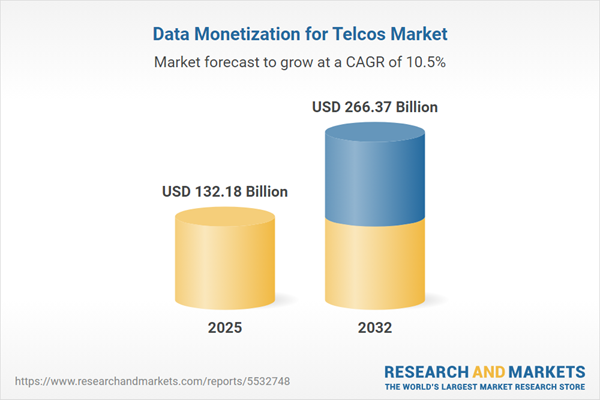Speak directly to the analyst to clarify any post sales queries you may have.
Telecommunications companies are transforming how they create value by adopting analytics-driven and data monetization strategies that help address ongoing digital shifts and regulatory pressures. Senior decision-makers now have an opportunity to unlock new business models and lead industry evolution by leveraging advanced data assets for operational and commercial gain.
Market Snapshot: Data Monetization for Telcos Market
The global data monetization for telcos market is advancing swiftly as telecom service providers move toward analytics-centric models and adopt broad digital transformation. The market is currently valued at USD 119.43 billion and is projected to increase to USD 132.18 billion by 2025, with forecasts of reaching USD 266.37 billion by 2032. This consistent expansion is backed by a compound annual growth rate of 10.54%. Leading industry players are strengthening their technology alliances, upgrading network infrastructure, and prioritizing innovation to maintain competitiveness. To support flexibility and agility, telecoms are increasing their investment in new solutions as they face competitive technology environments and heightened regulatory oversight.
Scope & Segmentation of the Data Monetization for Telcos Market
This executive summary presents actionable intelligence for telecom leaders striving to maximize the value of their data assets across evolving digital ecosystems. The report discusses essential commercial strategies, compliance requirements, risk management, and operational agility. The segmentation below details the key market components and their strategic significance:
- Service Type: Advanced analytics offer greater insights across operations; targeted advertising and value-added messaging support client acquisition and retention; streaming services and content integration diversify offerings and address enterprise as well as consumer demands.
- Deployment Mode: Private cloud, public cloud, and on-premises approaches allow telcos to address compliance rules by region, while supporting bespoke requirements for scalability and operational control.
- Pricing Model: Licensing, pay-per-use, and subscription provide flexible engagement models, enabling telcos to tailor commercial structures to enterprise or retail clients’ needs.
- Customer Type: Segmentation strategies address both enterprise and retail consumer audiences, enhancing targeted go-to-market activities while enabling adaptation to both B2B and B2C requirements.
- Industry Vertical: Collaboration with industries such as banking, insurance, healthcare, manufacturing, retail, IT, telecom, and transportation fosters cross-industry innovation and expands digital ecosystem opportunities.
- Geographic Coverage: The research offers specific insights for the Americas, Europe, Middle East and Africa, and Asia-Pacific regions, supporting decision-makers as they navigate local policy conditions and regional priorities.
- Key Companies Analyzed: Competitive benchmarks include leading firms such as Huawei Technologies, Ericsson, Nokia, Amdocs, Oracle, Netcracker, Cisco, CSG, Subex, and Comviva, providing operational and partnership alignment perspectives across the sector.
Key Takeaways for Senior Decision-Makers
- Adopting analytics-driven operating models allows for enhanced personalization and enables telecoms to respond quickly to diverse client needs, bolstering service impact and relevance in dynamic markets.
- Investments in network modernization and virtualization provide a foundation for integrating emerging technologies, supporting scalability and more agile service delivery.
- Segmenting offerings by customer type and service enables companies to reveal new revenue sources, use resources more efficiently, and improve operational outcomes.
- Robust collaboration with technology vendors and content partners builds resilience, helping organizations to adapt continuously as market demands and technologies develop.
- Prioritizing compliance frameworks tailored to local regulatory contexts ensures organizations remain proactive during policy changes and helps maintain business continuity.
Tariff Impact: United States Tariff Adjustments 2025
Upcoming US tariff changes create new dynamics for telecom procurement and supply chain strategy. Transitioning towards near-shoring and diversifying supplier networks can help mitigate exposure to volatility. Adopting software-defined networking and cloud-native infrastructure also strengthens business agility, allowing rapid responses to regulatory or economic changes.
Methodology & Data Sources
The report methodology integrates senior executive interviews, expert-led workshops, and direct collaboration with technology partners. These primary research activities are reinforced by established analytical frameworks, regulatory assessments, and structured competitive analyses, ensuring a high level of data reliability.
Why This Report Matters
- Supports telecom leaders in identifying high-impact investment areas by delivering precise, actionable market intelligence across major segments.
- Guides strategy refinement as the regulatory and commercial environment changes, helping organizations to maintain both compliance and flexibility.
- Provides sector-specific benchmarks that foster competitive positioning and accelerate transformation initiatives within telecom markets.
Conclusion
Telecom data monetization strategies are enabling business model transformation and strengthening long-term sector resilience. This research delivers the comprehensive insights leaders need to capture growth and manage industry disruptions effectively.
Additional Product Information:
- Purchase of this report includes 1 year online access with quarterly updates.
- This report can be updated on request. Please contact our Customer Experience team using the Ask a Question widget on our website.
Table of Contents
3. Executive Summary
4. Market Overview
7. Cumulative Impact of Artificial Intelligence 2025
Companies Mentioned
The companies profiled in this Data Monetization for Telcos market report include:- Huawei Technologies Co., Ltd.
- Telefonaktiebolaget LM Ericsson
- Nokia Corporation
- Amdocs Limited
- Oracle Corporation
- Netcracker Technology Corporation
- Cisco Systems, Inc.
- CSG Systems International, Inc.
- Subex Limited
- Comviva Technologies Limited
Table Information
| Report Attribute | Details |
|---|---|
| No. of Pages | 193 |
| Published | October 2025 |
| Forecast Period | 2025 - 2032 |
| Estimated Market Value ( USD | $ 132.18 Billion |
| Forecasted Market Value ( USD | $ 266.37 Billion |
| Compound Annual Growth Rate | 10.5% |
| Regions Covered | Global |
| No. of Companies Mentioned | 11 |









